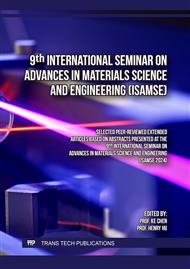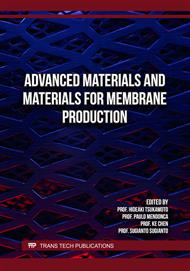[1]
Kang L, Yang C. A Review on High‐Strength Titanium Alloys: Microstructure, Strengthening, and Properties [J]. Advanced Engineering Materials, 2019, 21: 1801359.
Google Scholar
[2]
Gupta A, Khatirkar R, et al. A review of microstructure and texture evolution during plastic deformation and heat treatment of β-Ti alloys [J]. 2022, 899: 163242.
DOI: 10.1016/j.jallcom.2021.163242
Google Scholar
[3]
Wu C, Ma B, et al. Effect of delayed quenching on microstructure and properties of TC4 titanium alloy for aerospace fasteners [J]. Heat Treatment of Metals, 2023, 48(12): 135-139.
Google Scholar
[4]
Haubrich J, Gussone J, et al. The role of lattice defects, element partitioning and intrinsic heat effects on the microstructure in selective laser melted Ti-6Al-4V [J]. Acta Materialia, 2019, 167: 136-148.
DOI: 10.1016/j.actamat.2019.01.039
Google Scholar
[5]
Schur R, Ghods S, et al. Mechanical anisotropy and its evolution with powder reuse in Electron Beam Melting AM of Ti6Al4V [J]. Materials & Design, 2021, 200: 109450.
DOI: 10.1016/j.matdes.2021.109450
Google Scholar
[6]
An M, Lei Y, et al. Layer thickness dependent plastic deformation mechanism in Ti/TiCu dual-phase nano-laminates [J]. 2023, 32(6): 066201.
DOI: 10.1088/1674-1056/acb48f
Google Scholar
[7]
Boggarapu V, Gujjala R, et al. State of the art in functionally graded materials [J]. 2021, 262: 113596.
DOI: 10.1016/j.compstruct.2021.113596
Google Scholar
[8]
Zhang L, Liu G, et al. Effects of Al and V on deformation behavior and microscopic mechanism of titanium alloy at ultra-low temperature using molecular dynamics; proceedings of the Journal of Physics: Conference Series, F, 2024 [C]. IOP Publishing.
DOI: 10.1088/1742-6596/2713/1/012049
Google Scholar
[9]
An K Y, Ou X Q, et al. Effects of tensile temperatures on phase transformations in zirconium by molecular dynamics simulations [J]. Journal of Central South University, 2021, 28(7): 1932-1945.
DOI: 10.1007/s11771-021-4665-2
Google Scholar
[10]
Shen G, Chen X, et al. Effects of heat treatment processes on the mechanical properties, microstructure evolution, and strengthening mechanisms of Al–Mg–Zn–Cu alloy [J]. Journal of Materials Research and Technology, 2023, 27: 5380-5388.
DOI: 10.1016/j.jmrt.2023.11.070
Google Scholar



